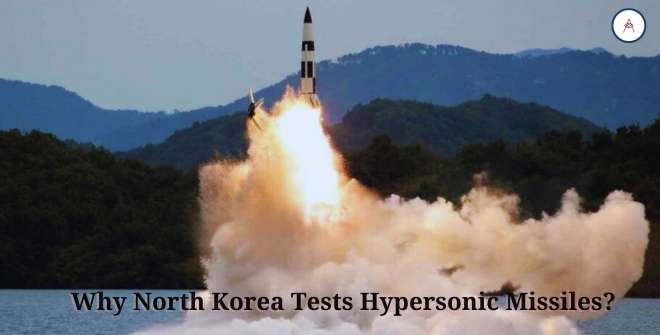Why North Korea Tests Hypersonic Missiles? Uncover the motivations behind North Korea’s hypersonic missile tests.
Explore geopolitical tensions, technological advancements, and strategic implications driving this controversial weaponry.
North Korea announced on Monday that it had tested a new solid-fueled hypersonic missile with an intermediate range, facing an attempt to develop the next generation of long-range rockets that can be identified and intercepted.
In recent years, other nations including the US, China, and Russia have also been working on building hypersonic weapons.
Table of Contents
Hypersonic missiles typically launch a warhead at five times the speed of sound, or around 6,200 km/h (3,850 mph), often at low altitudes.
Despite their name, scientists say the essential feature of hypersonic weapons is the ability to maneuver, not speed, which can occasionally match or exceed conventional ballistic missile warheads.
South Korean military authorities and analysts claim that while North Korea tested a glider-sized warhead in its first hypersonic missile test in 2021,
the country will test a ballistic missile or maneuverable re-entry vehicle (MaRV) in 2022. A missile warhead with the ability to strike the target was employed.
According to North Korean official media, the test on Sunday was conducted to evaluate the dependability of a medium-range hypersonic maneuverable control warhead and new multi-stage, high-thrust solid-fuel engines.
Combining a glide vehicle with a missile that may partially launch it into orbit, known as a fractional orbital bombardment system (FOBS), can minimize reaction time and eliminate enemies’ traditional defense systems.
Intercontinental ballistic missiles (ICBMs) deliver nuclear-powered warheads on ballistic trajectories that travel across space but never reach orbit.
WHO IS ON TOP OF THE RACE?
China launched a rocket in 2021 carrying a hypersonic glide vehicle, which circles the Earth and travels through space before falling short of its goal by roughly two dozen miles.
The Tsirkon (Zircon) hypersonic cruise missile, which President Vladimir Putin identified as a component of a new generation of missile systems, was successfully tested earlier this year in Russia.
Russian submarines and frigates conducted the weapon’s first-ever tests.
The first successful test of this type of weapon since 2013 was announced by the US in September 2021.
The weapon is an air-breathing hypersonic weapon, which means it stays in the atmosphere like a cruise missile. Experience is present.
North Korea’s Hyperbolic Objective
Securing hypersonic weapons is one of the five main targets under a five-year plan to increase military might, along with developing fuelled ICBMs and a nuclear submarine,
according to North Korean leader Kim Jong-un, who made this announcement at a major meeting of the ruling Workers’ Party in January 2021.
In September 2021, North Korea successfully launched its first hypersonic missile, describing it as a “strategic weapon” intended to strengthen its defenses.
However, some South Korean analysts deemed the test a failure.
North Korea launched a second possible hypersonic missile in January 2022, according to Seoul officials.
This missile can travel at speeds of up to ten times the speed of sound (12,348 km/h/7,673 mph) at comparatively low altitudes.

The launch on Sunday would have been Pyongyang’s first solid-fueled missile, allowing for rapid launches with little lead time.
Kim examined Moscow’s hypersonic missiles and other armaments last September during an uncommon trip to the country.
WHY IT IS IMPORTANT
The rush to create sophisticated long-range missiles is reflected in the global push for hypersonic weapons, which is being led by smaller Asian states with stronger armed forces.
Because they may be able to avoid early warning systems and missile defenses, hypersonic weapons and FOBS can be dangerous.
“North Korea appears to be trying to create hypersonic missiles and intermediate-range strategic missiles based on solid-propellant rocket boosters,” said Chang Young-kyun, a professor at Korea Aerospace University.
“In particular, medium- to long-range hypersonic missiles would be useful for attacking Guam while avoiding US missile defense systems.”



